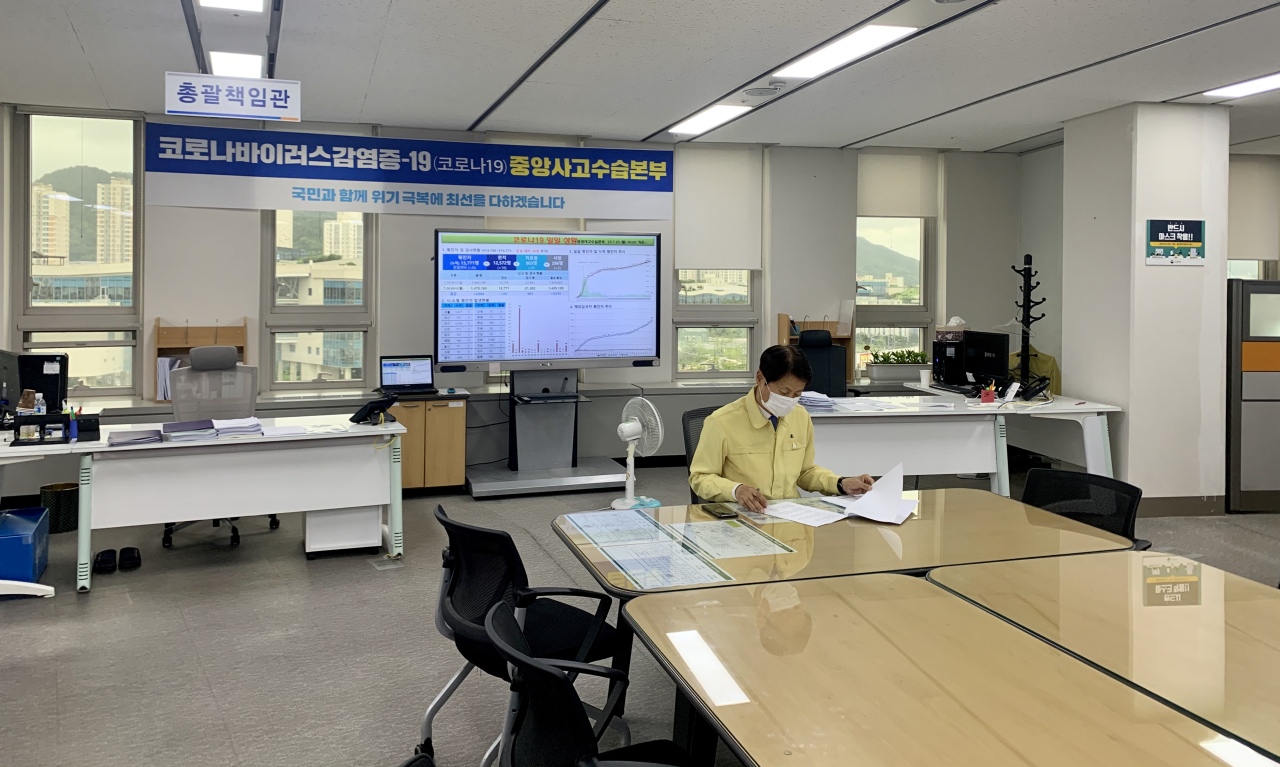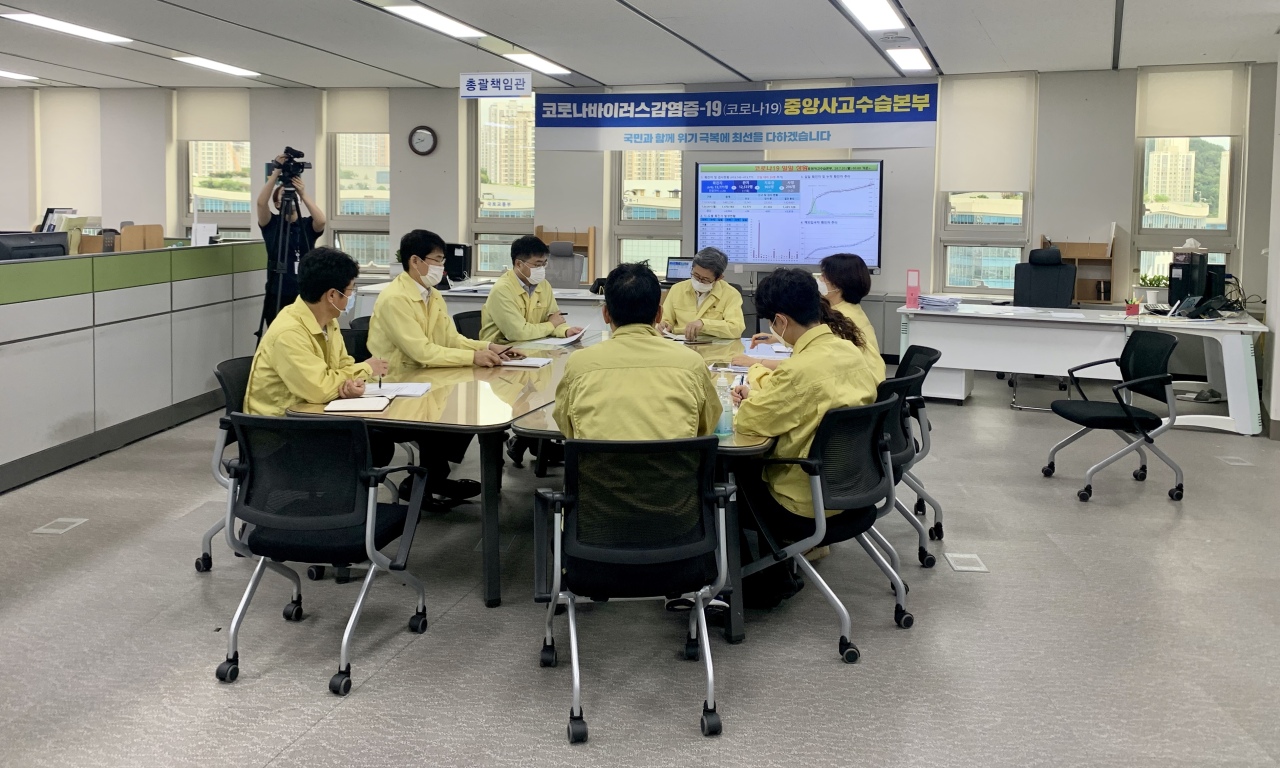[From the Scene] Inside S. Korea’s COVID-19 headquarters
By Kim ArinPublished : July 20, 2020 - 18:21

SEJONG -- The South Korean government’s coronavirus task force has expanded into a multidivision bureau with a semipermanent presence within the Ministry of Health and Welfare to brace for the pandemic’s lasting impact.
Formally titled the Central Disaster Management Headquarters, the body acts as the command post in Korea’s battle against COVID-19, coordinating and overseeing the efforts to monitor, mitigate and prevent the disease’s spread here.
“The central response unit underwent a makeover last week to keep up with the scale of the growing health emergency as well as to allow parts of the ministry to return to normal operations,” Yoon Tae-ho, the ministry’s director general for public health policy, told reporters on Monday.
As of Monday, some 254 officials comprise the unit’s 12 divisions -- 121 of whom are expected to stay put so long as the pandemic lasts. The rest will come and go depending on shifting demand. At its busiest moment, in March, over 300 had been mobilized.
The main coronavirus office was set up as a 113-member team in late January, when the government raised its COVID-19 alert status to the highest level. Officials of varying ranks were assembled for coronavirus duty, with their usual responsibilities brushed aside for the time being.
Since the first case emerged Jan. 20, coronavirus officials have been in “crunch mode,” Yoon said. “No one had anticipated then that the outbreaks would persist for over six months.

“The ministry’s begun to weigh long-term ramifications of putting non-coronavirus tasks -- which are just as pressing -- on hold,” he said.
A typical day at the response unit begins at 5 a.m. and ends around midnight, according to a deputy director. “For the first few months, most of us have been working monthly overtime of over 80 hours with only a few days off,” he said. Given the crushing workload, the staff are shuffled regularly to even out the burden.
But now that they’re past the initial scrambles, there is a secure system in place, he said. To pace for a potentially long-running crisis, the ministry has cut down the press briefings to three times a week.
Health spokesperson Son Young-rae said that because the situation was changing rapidly, the different divisions were taking turns coming under the spotlight.
“In February and March, when patient numbers peaked, the health care capacity management section was the busiest, for instance. These days the border measures team is probably the most occupied,” he said. On the agenda for Monday’s meeting was the rapid rise in imported cases over the past month.
He said the ministry’s unit was working closely with the Korea Centers for Disease Control and Prevention, which handles the “field work” aspect of disease control, such as testing and contact tracing.
Speaking to reporters, the headquarters’ second in command, Vice Minister of Health Kim Gang-lip, said the goal was to contain the outbreaks to a manageable level that would permit people to resume normal activities to a certain degree.
Looking back on nearly half a year into the fight against the virus, Kim said the health authorities were wary not to let complacency set in and readying for what might lie ahead in the months to come.
“What we need at this point are interventions that will stick for a long time.”
By Kim Arin (arin@heraldcorp.com)







![[Graphic News] More Koreans say they plan long-distance trips this year](http://res.heraldm.com/phpwas/restmb_idxmake.php?idx=644&simg=/content/image/2024/04/17/20240417050828_0.gif&u=)
![[KH Explains] Hyundai's full hybrid edge to pay off amid slow transition to pure EVs](http://res.heraldm.com/phpwas/restmb_idxmake.php?idx=644&simg=/content/image/2024/04/18/20240418050645_0.jpg&u=20240419100350)






![[From the Scene] Monks, Buddhists hail return of remains of Buddhas](http://res.heraldm.com/phpwas/restmb_idxmake.php?idx=652&simg=/content/image/2024/04/19/20240419050617_0.jpg&u=20240419175937)

![[KH Explains] Hyundai's full hybrid edge to pay off amid slow transition to pure EVs](http://res.heraldm.com/phpwas/restmb_idxmake.php?idx=652&simg=/content/image/2024/04/18/20240418050645_0.jpg&u=20240419100350)

![[Today’s K-pop] Illit drops debut single remix](http://res.heraldm.com/phpwas/restmb_idxmake.php?idx=642&simg=/content/image/2024/04/19/20240419050612_0.jpg&u=)